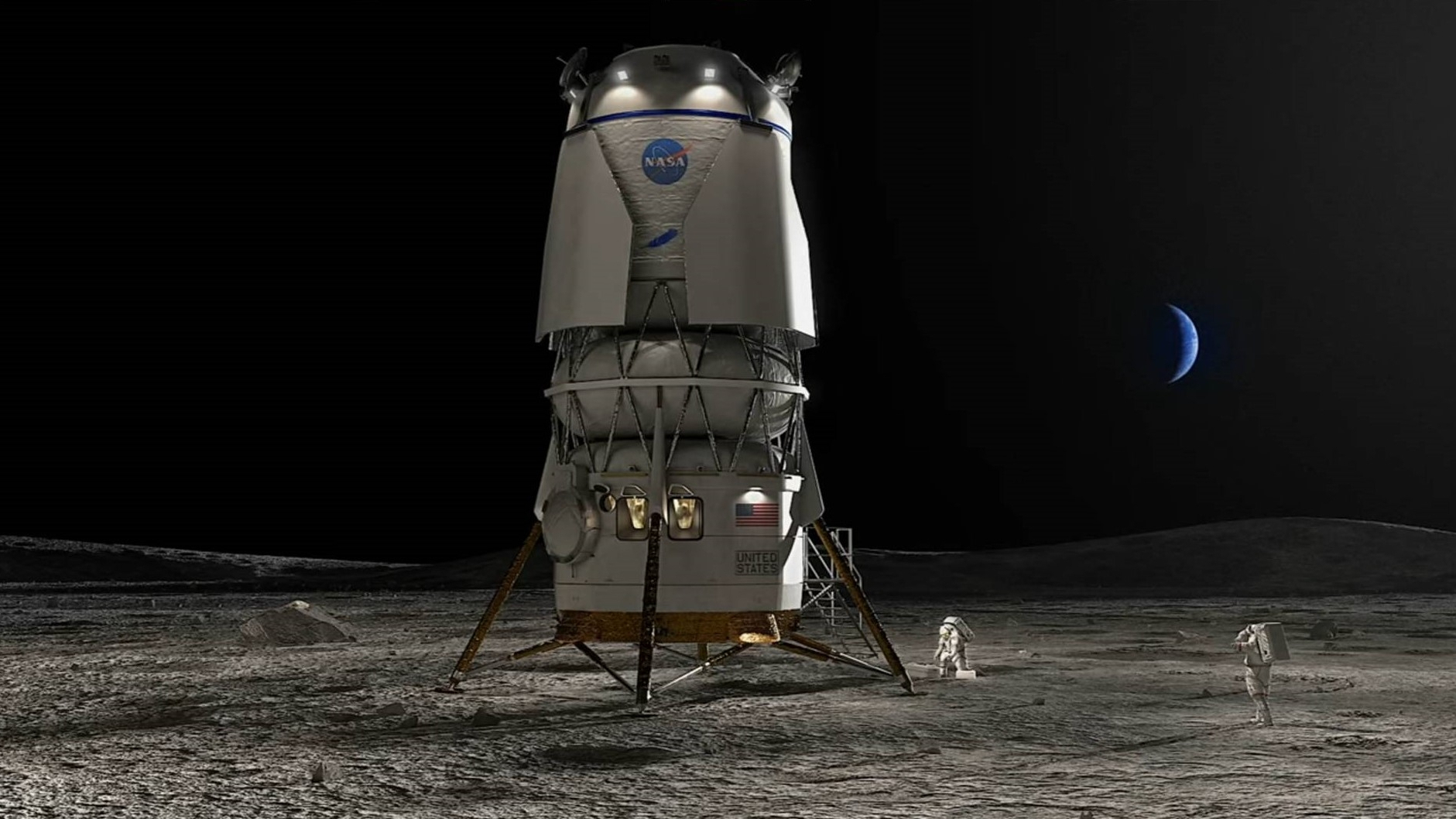
Lunar landers and 'Transporter' tankers: Blue Origin unveils its blueprint for the moon
"Prior to the end of this decade, we will be landing two crews on the lunar surface."

Blue Origin has begun revealing how it plans to establish itself as a provider of hardware to enable long-term human stays on the moon.
One newly unveiled key element is the "Transporter," a vehicle that can be launched on a single Blue Origin New Glenn rocket into low Earth orbit. It will harvest leftover propellant from the booster's second stage and then haul the hydrogen and oxygen to lunar orbit.
Transporter is designed to lug roughly 110 tons (100 metric tons) from Earth orbit to lunar orbit. And in Mars mode, it will be able to haul 33 tons (30 metric tons) into orbit around the Red Planet.

Making its mark
Blue Origin is also busily developing a robotic lander called Mark 1, as well as a Mark 2 version able to land up to four astronauts on the moon, either to equatorial or polar sites, depending on NASA requirements. A Mark 2 cargo-toting version has also been scoped out.
Mark 1 is capable of landing up to 3.3 tons (3 metric tons) on the moon. The larger Mark 2 vehicle can land up to 22 tons (20 metric tons) in a reusable configuration, or up to 33 tons (30 metric tons) in a one-way configuration, making it brawny enough to deliver habit modules to the lunar surface.
The Mark 2 lander is being developed under NASA's NextSTEP-2 Appendix P Sustaining Lunar Development (SLD) contract.

Hardware rich
John Couluris, senior vice president of lunar permanence for Blue Origin, detailed the company's plans during a Lunar Surface Innovation Consortium (LSIC) meeting held from May 20 to May 22 at the Johns Hopkins University Applied Physics Laboratory in Maryland.
Get the Space.com Newsletter
Breaking space news, the latest updates on rocket launches, skywatching events and more!
If we can open up the moon, Couluris said, it will become "our eventual hub for the rest of the solar system."
The pace of Blue Origin work on lunar hardware is palpable.
Couluris said Blue Origin is moving forward on becoming "hardware rich," with the firm's target to get the production line moving — to support reliable access to the moon in a low-cost manner.
Serial number one of the Mark 1 lunar lander, for example, is scheduled to fly to the moon's south pole for the first time this year.
If successful, Mark 1 would be the largest lander ever to touch down on the moon. Blue Origin is working with NASA's Commercial Lunar Payload Services (CLPS) initiative to outfit that first craft with the space agency's Stereo Cameras for Lunar Plume Surface Studies (SCALPSS) system, which will gauge the effects of the lander's engine plume on the dusty, rock-strewn lunar surface.
"We are currently building two of these vehicles," Couluris said, "to get hardware rich."
First moonshot
Couluris underscored a key challenge that Blue Origin is working on — figuring out a way to make hydrogen and oxygen storable for appreciable lengths of time. These are the propellants for Blue Origin's BE engine line, which powers the Mark 1 and Mark 2 landers and the Transporter.
Success in this area would therefore be huge, Couluris said.
"This opens up the solar system," making the moon a kind of JFK airport, according to Couluris.
And Blue Origin is making serious progress on its lander propulsion system, he added.
"The build of this engine that's going to power our first Mark 1 is almost complete and will be integrated into the vehicle probably late summer," said Couluris.
At Blue Origin's facility in Washington state, the zero-boil-off technology is advancing, already demonstrated to work at temperatures of 20 Kelvin (minus 424 degrees Fahrenheit) and 90 Kelvin (minus 298 F) in the lab.
"We're making our first moonshot this year," said Jacqueline Cortese, senior director of civil space at Blue Origin. "Prior to the end of this decade, we will be landing two crews on the lunar surface" in partnership with NASA's Artemis program, she added.
Blue Origin self-funded the Mark 1. No government resources went into the vehicle, Cortese told the LSIC audience. "Ideally, we will have a successful first mission of Mark 1, then incorporate any findings and be ready to fly again," she said.
The Mark 1 will not only be the largest lander to ever touch down on the moon but also the only liquid oxygen/hydrogen-fueled lander to do so, Cortese said.
"So, please keep your fingers, toes — anything — crossed for a successful first Mark 1 mission this year," she said. "It's been a long time coming for a lot of people at Blue Origin."

Reinvent traditional aerospace
The moon is a stepping stone to Mars, Blue Origin CEO Dave Limp said at the 2025 Humans to the Moon and Mars Summit (H2M2), hosted by Explore Mars, Inc. and held May 28 to May 29 at George Washington University in Washington, D.C.
"If we're going to get to Mars, the path to that is getting back to the moon, and in a permanent way," Limp said.
Limp also spotlighted Blue Origin's work on zero-boil-off technology and the firm's Transporter tanker. Lab demonstrations are "coming along really well," with the firm's first prototype cryo-cooler coming online in the next couple of months.
"I'm very optimistic that this is going to be a solved problem in the next year or two," said Limp.
Blue Origin is steadfast in its desire to dramatically lower the price of launching material from Earth, Limp said. And doing so means innovation by commercial companies, he added.
"We want to reinvent traditional aerospace," said Limp. "We want to go faster. We want to be more decisive. We want to do it in a more cost-effective way. You can't use the traditional aerospace playbook and do all those things."
Driving demand
Of similar view is Brian Ippolitto, senior director of operations at Marotta Controls, an innovative aerospace and defense company.
"Commercial space leaders are actively positioning themselves at the forefront of cislunar and lunar development," Ippolitto told Space.com.
"As they continue to design and build platforms capable of operating beyond low Earth orbit, they are driving demand for more advanced and reliable components that can endure the extreme conditions of deep space," said Ippolitto.
Among the most significant challenges ahead, Ippolitto pointed out, "are the requirements for colder operating temperatures and longer-duration missions — both critical to the success of sustained lunar presence."
Join our Space Forums to keep talking space on the latest missions, night sky and more! And if you have a news tip, correction or comment, let us know at: community@space.com.

Leonard David is an award-winning space journalist who has been reporting on space activities for more than 50 years. Currently writing as Space.com's Space Insider Columnist among his other projects, Leonard has authored numerous books on space exploration, Mars missions and more, with his latest being "Moon Rush: The New Space Race" published in 2019 by National Geographic. He also wrote "Mars: Our Future on the Red Planet" released in 2016 by National Geographic. Leonard has served as a correspondent for SpaceNews, Scientific American and Aerospace America for the AIAA. He has received many awards, including the first Ordway Award for Sustained Excellence in Spaceflight History in 2015 at the AAS Wernher von Braun Memorial Symposium. You can find out Leonard's latest project at his website and on Twitter.
You must confirm your public display name before commenting
Please logout and then login again, you will then be prompted to enter your display name.
